Zhiwen Pan
Overview of AI and Communication for 6G Network: Fundamentals, Challenges, and Future Research Opportunities
Dec 19, 2024



Abstract:With the increasing demand for seamless connectivity and intelligent communication, the integration of artificial intelligence (AI) and communication for sixth-generation (6G) network is emerging as a revolutionary architecture. This paper presents a comprehensive overview of AI and communication for 6G networks, emphasizing their foundational principles, inherent challenges, and future research opportunities. We commence with a retrospective analysis of AI and the evolution of large-scale AI models, underscoring their pivotal roles in shaping contemporary communication technologies. The discourse then transitions to a detailed exposition of the envisioned integration of AI within 6G networks, delineated across three progressive developmental stages. The initial stage, AI for Network, focuses on employing AI to augment network performance, optimize efficiency, and enhance user service experiences. The subsequent stage, Network for AI, highlights the role of the network in facilitating and buttressing AI operations and presents key enabling technologies, including digital twins for AI and semantic communication. In the final stage, AI as a Service, it is anticipated that future 6G networks will innately provide AI functions as services and support application scenarios like immersive communication and intelligent industrial robots. Specifically, we have defined the quality of AI service, which refers to the measurement framework system of AI services within the network. In addition to these developmental stages, we thoroughly examine the standardization processes pertinent to AI in network contexts, highlighting key milestones and ongoing efforts. Finally, we outline promising future research opportunities that could drive the evolution and refinement of AI and communication for 6G, positioning them as a cornerstone of next-generation communication infrastructure.
STAR-RIS in Cognitive Radio Networks
Nov 30, 2024



Abstract:The development of sixth-generation (6G) communication technologies is confronted with the significant challenge of spectrum resource shortage. To alleviate this issue, we propose a novel simultaneously transmitting and reflecting reconfigurable intelligent surface (STAR-RIS) aided multiple-input multiple-output (MIMO) cognitive radio (CR) system. Specifically, the underlying secondary network in the proposed CR system reuses the same frequency resources occupied by the primary network with the help of the STAR-RIS. The secondary network sum rate maximization problem is first formulated for the STAR-RIS aided MIMO CR system. The adoption of STAR-RIS necessitates an intricate beamforming design for the considered system due to its large number of coupled coefficients. The block coordinate descent method is employed to address the formulated optimization problem. In each iteration, the beamformers at the secondary base station (SBS) are optimized by solving a quadratically constrained quadratic program (QCQP) problem. Concurrently, the STAR-RIS passive beamforming problem is resolved using tailored algorithms designed for the two phase-shift models: 1) For the independent phase-shift model, a successive convex approximation-based algorithm is proposed. 2) For the coupled phase-shift model, a penalty dual decomposition-based algorithm is conceived, in which the phase shifts and amplitudes of the STAR-RIS elements are optimized using closed-form solutions. Simulation results show that: 1) The proposed STAR-RIS aided CR communication framework can significantly enhance the sum rate of the secondary system. 2) The coupled phase-shift model results in limited performance degradation compared to the independent phase-shift model.
Lightweight Deep Learning Based Channel Estimation for Extremely Large-Scale Massive MIMO Systems
Feb 14, 2024



Abstract:Extremely large-scale massive multiple-input multiple-output (XL-MIMO) systems introduce the much higher channel dimensionality and incur the additional near-field propagation effect, aggravating the computation load and the difficulty to acquire the prior knowledge for channel estimation. In this article, an XL-MIMO channel network (XLCNet) is developed to estimate the high-dimensional channel, which is a universal solution for both the near-field users and far-field users with different channel statistics. Furthermore, a compressed XLCNet (C-XLCNet) is designed via weight pruning and quantization to accelerate the model inference as well as to facilitate the model storage and transmission. Simulation results show the performance superiority and universality of XLCNet. Compared to XLCNet, C-XLCNet incurs the limited performance loss while reducing the computational complexity and model size by about $10 \times$ and $36 \times$, respectively.
Near-Field Integrated Sensing, Positioning, and Communication: A Downlink and Uplink Framework
Nov 13, 2023



Abstract:A near-field integrated sensing, positioning, and communication (ISPAC) framework is proposed, where a base station (BS) simultaneously serves multiple communication users and carries out target sensing and positioning. A novel double-array structure is proposed to enable the near-field ISPAC at the BS. Specifically, a small-scale assisting transceiver (AT) is attached to the large-scale main transceiver (MT) to empower the communication system with the ability of sensing and positioning. Based on the proposed framework, the joint angle and distance Cram\'er-Rao bound (CRB) is first derived. Then, the CRB is minimized subject to the minimum communication rate requirement in both downlink and uplink ISPAC scenarios: 1) For downlink ISPAC, a downlink target positioning algorithm is proposed and a penalty dual decomposition (PDD)-based double-loop algorithm is developed to tackle the non-convex optimization problem. 2) For uplink ISPAC, an uplink target positioning algorithm is proposed and an efficient alternating optimization algorithm is conceived to solve the non-convex CRB minimization problem with coupled user communication and target probing design. Both proposed optimization algorithms can converge to a stationary point of the CRB minimization problem. Numerical results show that: 1) The proposed ISPAC system can locate the target in both angle and distance domains merely relying on single BS and limited bandwidths; and 2) the positioning performance achieved by the hybrid-analog-and-digital ISPAC approaches that achieved by fully digital ISPAC when the communication rate requirement is not stringent.
Statistical CSI Based Beamforming for Reconfigurable Intelligent Surface Aided MISO Systems with Channel Correlation
Sep 27, 2023



Abstract:Reconfigurable intelligent surface (RIS) is a promising candidate technology of the upcoming Sixth Generation (6G) communication system for its ability to provide unprecedented spectral and energy efficiency increment through passive beamforming. However, it is challenging to obtain instantaneous channel state information (I-CSI) for RIS, which obliges us to use statistical channel state information (S-CSI) to achieve passive beamforming. In this paper, RIS-aided multiple-input single-output (MISO) multi-user downlink communication system with correlated channels is investigated. Then, we formulate the problem of joint beamforming design at the AP and RIS to maximize the sum ergodic spectral efficiency (ESE) of all users to improve the network capacity. Since it is too hard to compute sum ESE, an ESE approximation is adopted to reformulate the problem into a more tractable form. Then, we present two joint beamforming algorithms, namely the singular value decomposition-gradient descent (SVD-GD) algorithm and the fractional programming-gradient descent (FP-GD) algorithm. Simulation results show the effectiveness of our proposed algorithms and validate that 2-bits quantizer is enough for RIS phase shifts implementation.
Channel Estimation for Reconfigurable Intelligent Surface-Aided Multiuser Communication Systems Exploiting Statistical CSI of Correlated RIS-User Channels
Sep 27, 2023



Abstract:Reconfigurable intelligent surface (RIS) is a promising candidate technology for the upcoming Sixth Generation (6G) communication system for its ability to manipulate the wireless communication environment by controlling the coefficients of reflection elements (REs). However, since the RIS usually consists of a large number of passive REs, the pilot overhead for channel estimation in the RIS-aided system is prohibitively high. In this paper, the channel estimation problem for a RIS-aided multi-user multiple-input-single-output (MISO) communication system with clustered users is investigated. First, to describe the correlated feature for RIS-user channels, a beam domain channel model is developed for RIS-user channels. Then, a pilot reuse strategy is put forward to reduce the pilot overhead and decompose the channel estimation problem into several subproblems. Finally, by leveraging the correlated nature of RIS-user channels, an eigenspace projection (EP) algorithm is proposed to solve each subproblem respectively. Simulation results show that the proposed EP channel estimation scheme can achieve accurate channel estimation with lower pilot overhead than existing schemes.
Near-Field Beamforming for STAR-RIS Networks
Jun 26, 2023



Abstract:Recently, simultaneously transmitting and reflecting reconfigurable intelligent surfaces (STAR-RISs) have received significant research interest. The employment of large STAR-RIS and high-frequency signaling inevitably make the near-field propagation dominant in wireless communications. In this work, a STAR-RIS aided near-field multiple-input multiple-multiple (MIMO) communication framework is proposed. A weighted sum rate maximization problem for the joint optimization of the active beamforming at the base station (BS) and the transmission/reflection-coefficients (TRCs) at the STAR-RIS is formulated. The non-convex problem is solved by a block coordinate descent (BCD)-based algorithm. In particular, under given STAR-RIS TRCs, the optimal active beamforming matrices are obtained by solving a convex quadratically constrained quadratic program. For given active beamforming matrices, two algorithms are suggested for optimizing the STAR-RIS TRCs: a penalty-based iterative (PEN) algorithm and an element-wise iterative (ELE) algorithm. The latter algorithm is conceived for STAR-RISs with a large number of elements. Numerical results illustrate that: i) near-field beamforming for STAR-RIS aided MIMO communications significantly improves the achieved weighted sum rate compared with far-field beamforming; ii) the near-field channels facilitated by the STAR-RIS provide enhanced degrees-of-freedom and accessibility for the multi-user MIMO system; and iii) the BCD-PEN algorithm achieves better performance than the BCD-ELE algorithm, while the latter has a significantly lower computational complexity.
Unsupervised Deep Anomaly Detection for Multi-Sensor Time-Series Signals
Aug 02, 2021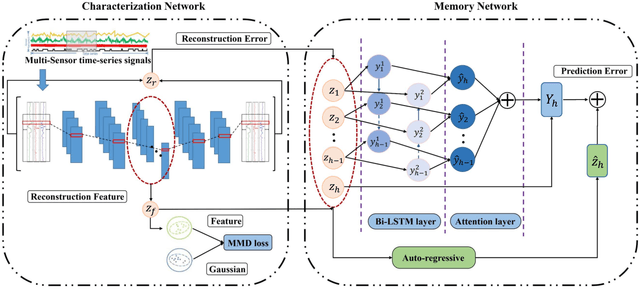


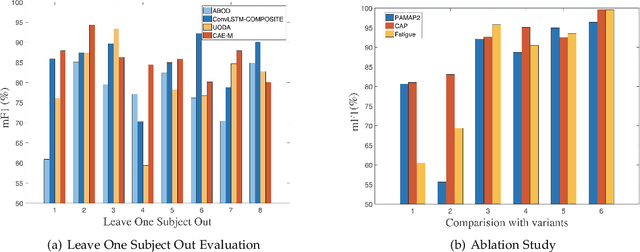
Abstract:Nowadays, multi-sensor technologies are applied in many fields, e.g., Health Care (HC), Human Activity Recognition (HAR), and Industrial Control System (ICS). These sensors can generate a substantial amount of multivariate time-series data. Unsupervised anomaly detection on multi-sensor time-series data has been proven critical in machine learning researches. The key challenge is to discover generalized normal patterns by capturing spatial-temporal correlation in multi-sensor data. Beyond this challenge, the noisy data is often intertwined with the training data, which is likely to mislead the model by making it hard to distinguish between the normal, abnormal, and noisy data. Few of previous researches can jointly address these two challenges. In this paper, we propose a novel deep learning-based anomaly detection algorithm called Deep Convolutional Autoencoding Memory network (CAE-M). We first build a Deep Convolutional Autoencoder to characterize spatial dependence of multi-sensor data with a Maximum Mean Discrepancy (MMD) to better distinguish between the noisy, normal, and abnormal data. Then, we construct a Memory Network consisting of linear (Autoregressive Model) and non-linear predictions (Bidirectional LSTM with Attention) to capture temporal dependence from time-series data. Finally, CAE-M jointly optimizes these two subnetworks. We empirically compare the proposed approach with several state-of-the-art anomaly detection methods on HAR and HC datasets. Experimental results demonstrate that our proposed model outperforms these existing methods.
Deep Multi-Stage CSI Acquisition for Reconfigurable Intelligent Surface Aided MIMO Systems
Apr 23, 2021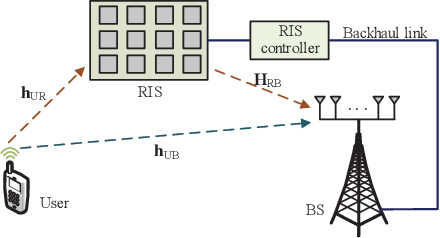
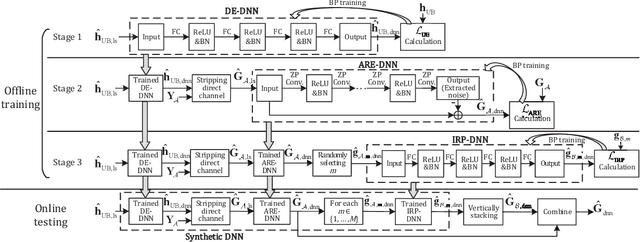
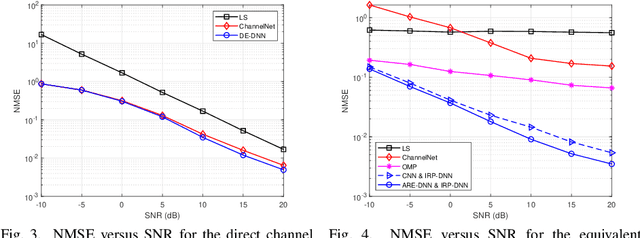
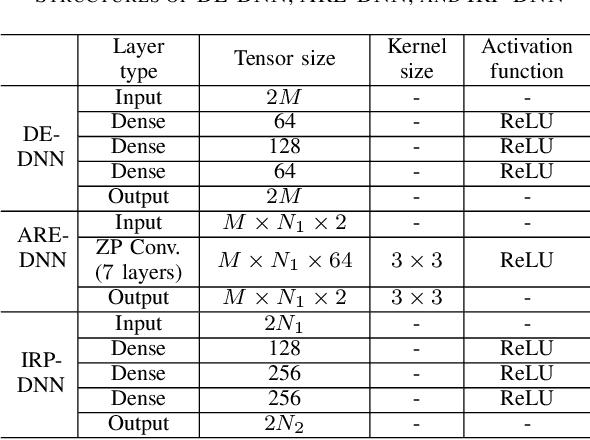
Abstract:This article aims to reduce huge pilot overhead when estimating the reconfigurable intelligent surface (RIS) relayed wireless channel. Motivated by the compelling grasp of deep learning in tackling nonlinear mapping problems, the proposed approach only activates a part of RIS elements and utilizes the corresponding cascaded channel estimate to predict another part. Through a synthetic deep neural network (DNN), the direct channel and active cascaded channel are first estimated sequentially, followed by the channel prediction for the inactive RIS elements. A three-stage training strategy is developed for this synthetic DNN. From simulation results, the proposed deep learning based approach is effective in reducing the pilot overhead and guaranteeing the reliable estimation accuracy.
Reinforcement Learning Based Cooperative Coded Caching under Dynamic Popularities in Ultra-Dense Networks
Mar 08, 2020
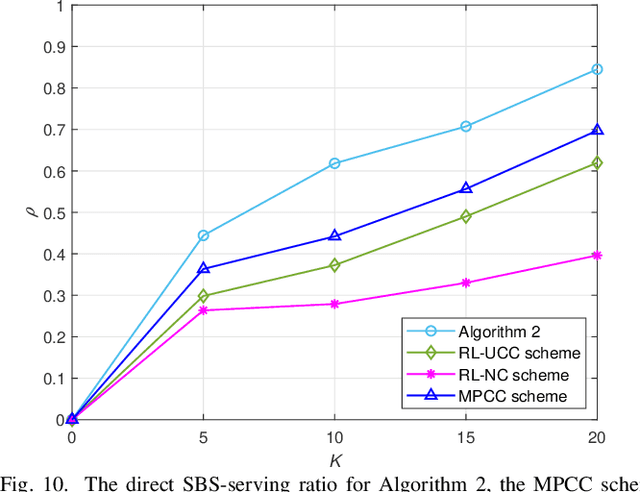

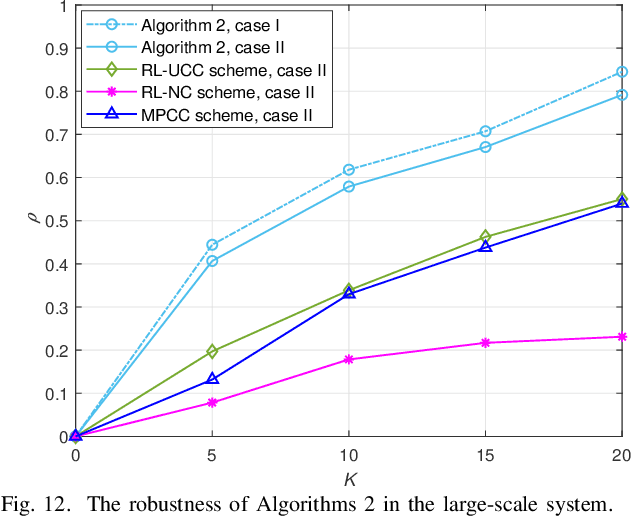
Abstract:For ultra-dense networks with wireless backhaul, caching strategy at small base stations (SBSs), usually with limited storage, is critical to meet massive high data rate requests. Since the content popularity profile varies with time in an unknown way, we exploit reinforcement learning (RL) to design a cooperative caching strategy with maximum-distance separable (MDS) coding. We model the MDS coding based cooperative caching as a Markov decision process to capture the popularity dynamics and maximize the long-term expected cumulative traffic load served directly by the SBSs without accessing the macro base station. For the formulated problem, we first find the optimal solution for a small-scale system by embedding the cooperative MDS coding into Q-learning. To cope with the large-scale case, we approximate the state-action value function heuristically. The approximated function includes only a small number of learnable parameters and enables us to propose a fast and efficient action-selection approach, which dramatically reduces the complexity. Numerical results verify the optimality/near-optimality of the proposed RL based algorithms and show the superiority compared with the baseline schemes. They also exhibit good robustness to different environments.
 Add to Chrome
Add to Chrome Add to Firefox
Add to Firefox Add to Edge
Add to Edge